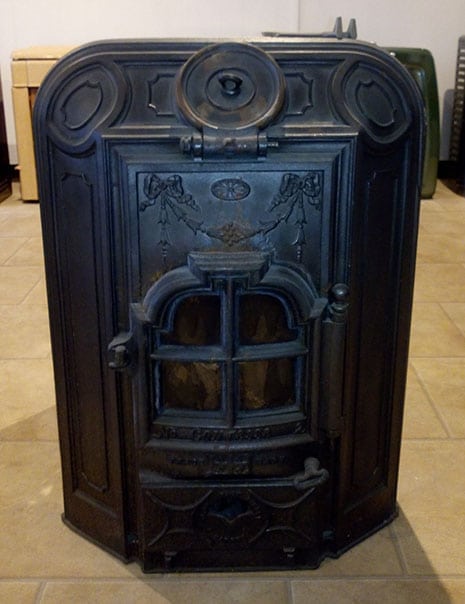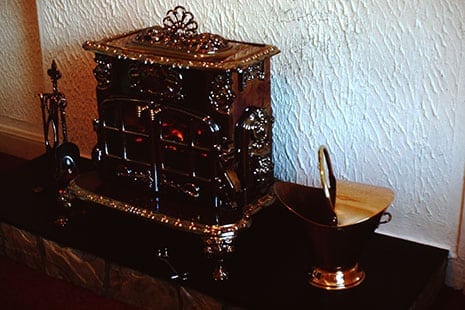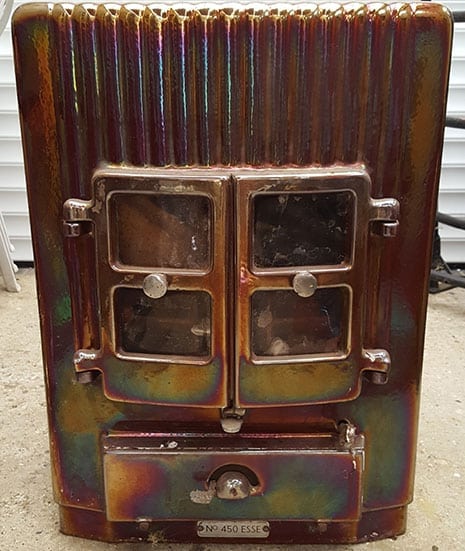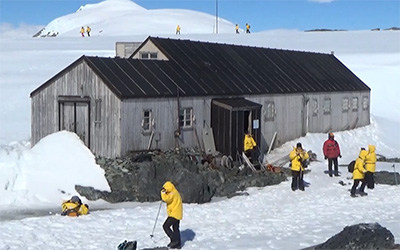
This section contains an ever-expanding collection of ESSE's iconic heritage stoves. These stoves represent ESSE's original bloodline, including the handcrafting, cast engineering and performance fire box design that still features in every ESSE stove today.
- Autovector
- BOGIE
- Bontesse
- Century
- Contesse
- DORIC
- Dragon
- Dolphin
- ESSE 450
- ESSE Fairy
- ESSE Vista
- Francesse
- Jeunesse
- Lucesse
- Mrs Sam
- Romesse
DORIC
Use of the product name “DORIC” was repeated over a century for a variety of Smith & Wellstood kitchen range and warming stove designs.
In 1895 a DORIC slow combustion warming stove was listed in the Smith & Wellstood catalogue.
Characterised by a simple austere column and circular capital, “DORIC” was produced in two sizes. A suitable pattern for small offices, shops, or other apartments. The Smoke Collar was on top, and the fire fed from the opening on top.
Turn of the 19th Century The “DORIC” Range is listed, available in two sizes, Nos 7 and 8, with and without Boiler. Designed specially for the varying requirements of the South African Colonies. An exceedingly rapid Cooker with minimum fuel usage. An improved pattern with elevated steel hot closet is added.
The chief task of the Smith & Wellstood laboratory following the war was to narrow the wide gap in performance between the “ESSE” cooker and the ordinary kitchen range or stove, principally by applying various types of installation, as in the “Doric,” “Wellstood,” and “President” cookers. The “ESSE” heat storage principle is, and probably always will be, the most efficient method for cooking by solid fuel, post-war research brought these cheaper models up to a high pitch of efficiency and created a wide sale for them among people who valued cleanliness in the kitchen and wanted to make the most of their fuel ration.
1952 – The DORIC Cooker and Water heater. A modern solid fuel cooker specially designed for small homes. Four-pan sized hotplate and roomy oven (13 ½ in. by 13 ¾ in. by 14 in.) with thermometer. Any solid fuel is suitable. Continuous cooking service and hot water for approximately 1 ¼ cwt. Weekly. Openable fire. Porcelain enamel finish in ivory mottle or white/grey mottle. Approved by Ministry of Fuel and Power.








DOLPHIN
A Smith & Wellstood continuous-burning fire, made in Bonnybridge, Scotland. An early 19th Century cast iron wood burning stove, with a pierced hinged lid, the front a reserve crest of a dolphin above two doors, raised on cabriole feet, 680mm high, 765mm wide, 450mm deep.
The ESSE Dolphin had 4 shaped pieces of glass in each door and formed part of a suite of four stove models that included the ESSE Dragon. Similar to the Dragon, smaller base dimensions allow its use where hearth space is limited. The decorative top conceals hostess facilities.
Use of the name Dolphin was recorded from pre 1900 through to 1980. The dolphin was the emblem of Smith & Wellstood and of Bonnybridge and the Masonic Lodge Dolphin. It had close connections with the Smith (Smith & Wellstood) family crest. The story told of Mr James Smith, of the aforesaid firm, having been shipwrecked and being kept watch over by a group of dolphins while in the sea.
Tranquillus in mediis undiis - Calm in the middle of the waves










Century
Manufactured by Smith & Wellstood, the ESSE CENTURY heat storage range cooker was introduced in 1954 to mark the occasion of the Company’s Centenary. The first models were suitable for burning ANY solid fuel and in 1958 the oil-fired CENTURY offered the owner a choice of fuel. ESSE Engineering also used the name ‘CENTURY’ for the oil fired range cooker produced from the year 2000 to 2018.
ESSE CENTURY offered warmth, hot water and cooking with two thermostatic controlled ovens and a 6-pan hotplate on less than 2cwt of fuel. It was produced in cream, white, apple green, dove grey and powder blue enamels with chrome plated fittings and could be purchased for £139 or a ‘practical 4-year pay-as-you-use plan’ that included installation.
In 1959 the ESSE CENTURY Cooker formed part of the kitchen set in the film “The Lady is a Square” featuring Anna Beagle, Frankie Vaughan and Janette Scott.










“BOGIE,” New Pattern 1895
(REGISTERED TRADE MARK TITLE).
EIGHT SIZES – Nos. 1, 2, 3, 4, 5, 6, 7, and 8.
CONSTRUCTED on the best principle, and is a handsome new design of the popular “DUMPY” pattern, suitable for fo’castle or cabin use, &c. Smoke Collar is from top, and unlike the old-fashioned Stoves of this shape, the “BOGIE” is cast in separate plates, rendering it secure against fracture, the five larger sizes having Fire-Brick, and the three smaller sizes Iron Linings in Fire Chamber. Rings in sides for lashing to deck, and Fender Pan can be screwed to deck also, rendering Stove secure against shifting in the severest weather.
“BOGIE” remained in production for over 40 years and the appearance was modified from time to time, the original cast iron finish was supplemented by enamel finishes.
The model pictured below is of the 1930’s IMPROVED BOGIE type. The illustrations show the original design.
“DUMPY”
FO’CASTLE OR CABIN STOVE.
FOR FO’CASTLE OR CABIN USE, &c.
These Stoves are constructed on the best principal for convenience and durability, and unlike the old-fashioned Stoves of this shape, are, all sizes, linked with Fire Bricks, which obviates the “burnt air” feeling common to the old kind, and renders the Stove much more durable. The Smoke Collar is at the back. Elbows to suit are supplied at small extra cost.
SIZES
No. 1, 22 in. high by 10 ½ in. wide over hearth
No. 5, 26 in. high by 14 ½ in. wide over hearth







Autovector
The Autovector was a hopper fed, closed stove with glass panelled door, the first in the UK, and had a novel ‘clip-in’ electric fire for summer use. Made in three sizes No’s 30, 50 and 25 – the 30 and 50 models had a unique shape, and were accepted by the Council of Industrial Design for the Design Index.
This particular model pictured was bought in 1953 by a gentleman for his wife, unfortunately she didn’t like the stove, so it was placed in the garage and was later found by his family who returned the stove back to ESSE, in the original and unused condition.
Excerpt from S&W Magazine October 1956. Vol. 8. No. 4
‘For as long as any of us can remember most people in this country have insisted on sending 75, 80 or an even greater percentage of the heat from their yearly fuel supply merrily up the chimney.
But today fuel has become far too expensive to waste. Men and women everywhere are glad to adopt new ideas which result in lower weekly or monthly fuel bills. The result is that a great variety of heating appliances is now available. Yet none is more efficient that the closed fired ESSE stove, which in its original form was marketed at the beginning of the century.
Now with the advent of the latest ESSE –
The automatic AUTOVECTOR with glass fire panel – the most efficient type of solid fuel home heater becomes acceptable even to the conservative armchair enthusiast who insists on a clear view of the fire. The other day we overheard a customer who had been contemplating an AUTOVECTOR in operation in our Glasgow showrooms remark to Mr. Stott: “This is what I have been waiting for. It doesn’t only heat the place: it keeps you company too!”
It is worth reflecting too that the Clean Air Act, 1956, reached the Statute Book recently. Its purpose is to ensure that “dark smoke shall not be emitted from a chimney of any building, and if, on any day, dark smoke is so emitted, the occupier of the building shall be guilty of an offence”.
The ESSE AUTOVECTOR fits the bill for smoke-less zones exactly; it’s the heater for today and tomorrow.’



The Bontesse
Circa 1990
Believed to be the first British stove capable of burning anthracite and coke, the Bontesse is based on French design and was the first ESSE stove.
The forerunner of Artesse, Francesse etc, this led to the adoption of the trade name ESSE. The stove could run for up to 24 hours a day, and introduced the nickel-plated Armesse finish, and later, the Majolica enamelled process.
Bontesse No 2 in Armesse finish.


Contesse
PATENT ESSE STOVES
The series began with the Bontesse and was added to with the Francesse, Contesse and the Artesse. Following response from mine owners for a stove to burn their product, particularly in South Wales and Scotland, the stoves were all designed to burn anthracite efficiently as it wouldn’t burn on an open fire.
As a gesture of goodwill, the mine owners bestowed an accolade on Smith & Wellstood, by naming the fuel for these stoves ‘Stovesse’, a name that still exists in the coal trade today.
The joints on these stoves were made absolutely airtight, no dust, smoke or fumes could escape to the room. So much so that The Institute of Hygiene awarded them the Certificate of Merit, and the stoves were used in hospitals. The stoves were finished in many different colours, from White, Teapot Brown, Bronze, Green, Leaf Green and Grey. Dark Blue, Light Blue, Old Gold and Ruby Red were available at a higher costs. The enamel was burnt onto the stove at a high temperature to give a beautiful finish.

The Dragon Stove
Circa 1977
Created in 1977 using the ornate patterns of the No 2 Frame design, cut apart and increased in size by skilled pattern makers in Bonnybridge, the idea was to produce a stove of Victorian appearance, but with modern technology for efficient performance. The Dragon stove rapidly gained popularity int eh export markets, and sold in large quantities until an identical copied design appeared from Taiwan.
The copied stove was sold in the USA as the Park Lane, in Europe as the Orka and in Australia as the Southlanders, with the cost being only a third of the original. Legal action over the copyright was fought and won in Holland and Australia, but ESSE's sales of the Dragon dwindles, and it was not possible to sue Taiwan manufacturers. However, Moa Shing Enterprises wrote to Smith & Wellstood in 1982, apologising for innocently copying the dragon, and offered to sell them their Dragon since the Taiwan version was so much cheaper - minimum order was one full container of 140 stoves!


ESSE 450
The NO. 450 ESSE is a courtier stove produced in mid-50’s to burn ‘Stovesse’ anthracite fuel. Sold into British rail station platform offices it was popular as you could view the fire through the mica doors.
This colour is called Copper Lustre, achieved by spraying a brown enamel base coat with a weak solution of methylated spirits and ferric chloride at a red hot temperature of 800˚ to create the lacquered iridescent burnished sheen.

ESSE Fairy
The ESSE COOKER Company prospered throughout the 19th and early 20th centuries. In the late 1950s ESSE Cookers held a royal warrant, ‘By Appointment To Her Majesty The Queen Manufacturers of ESSE Cooking Equipment’. Models such as the ESSE Fairy and the ESSE Century were purchased for the cook in royal households throughout Europe. Plus Auguste Escoffier and Mrs Beeton were users of ESSE.
2016 Andy McDonald-Brown contacted ESSE to tell us about his expedition to Goudier Island in the Antarctic where he visited the disused British Antarctic Survey Base originally built in Port Lockroy.
The Base was established in February 1944 as part of Operation Tabarin, a British World War 2 expedition. It was operational until 1962 and remains as a museum today.
Inside the base is an ESSE Fairy cooker, still in great condition after all these years, used for cooking, heating and drying clothes. One of the 'interesting' regional delicacies cooked on it was Seal Brain Omelette using Penguin eggs!
2017 Julian Davey from Cumbria spotted an ESSE Fairy (circa 1930) during an expedition to Detaille Island in the Antarctic, pictures and short videos below.
ESSE has a long-standing association with British exploration of Antarctica. Both Scott and Shackleton relied upon ESSE heating products for their pioneering expeditions and many of these cook stoves remain at various bases across the continent.
A team from the British Antarctic Survey recently returned from a visit to Rothera Research Station, Antarctica, near the northern tip of the Antarctic Peninsula, and found ESSE cook stoves still in situ at Port Lockroy and Deception Island.
The temperature in Northern Antarctica hovers around 0˚C in December – and that’s in the middle of the Southern Hemisphere Summer!
John Hamilton, purser on the icebreaking research and supply vessel RRS James Clark Ross said: "I thought it was amazing that British Engineering helped British science and environmental studies in such far off places. In these hostile environments, where everything else disintegrates, the stove remains."
A couple of thousand miles to the west on this huge landmass, the stove chimney at Shackleton’s Base at Cape Royds is actually visible on Google Streetview (simply key in ‘Shackleton’s Hut, Antarctica. There’s no postcode…) and there are more images here.
If you spot an ESSE whilst on your travels, please capture a photograph and send to us through social media @ESSE1854 or email to enquiries@esse.com.








ESSE Vista
Circa 1925
The curved sliding fire door of this stove is a unique feature, that gave, when open, a full view of the fire as the door would slide behind the outer body. The ornamental top covered a boiling plate and a patented damper would automatically open when the doors were slid back, to prevent fume emissions. This damper would close with the doors to allow greater efficiency.
The ESSE Vista was available in a nickel-plated finish (Armesse) or coloured Majolica enamel in Teapot Brown, Moss Green and Royal Blue. The model pictured is in Moss Green, although it is a bit worse for wear after 40 years of service.



Francesse
THE FAMOUS FAMILY OF ESSE ANTHRACITE BURNING STOVES
This series began with the Bontesse and was added to by the Francesse, Contesse, Lucesse and Artesse. Similar in technique but differing in appearance, all the models were designed to burn anthracite efficiently, in response to an appeal from the mine owners for a stove to burn their product. Anthracite was in plentiful supply, particularly in South Wales and Scotland but without a domestic heating market, since anthracite would not burn on open type fires.
As a gesture of thanks, the anthracite suppliers bestowed an accolade on Smith & Wellstood by naming the fuel for these stoves “STOVESSE”, a name which still exists in the coal trade today.
The stoves were made in a variety of sizes and finishes, including black paint, nickel plated and Majolica enamel in a variety of colours. The 1914 catalogue shows the following stoves –
CONTESSE
FRANCESSE
ARTESSE
Examples exhibited in the heritage stove display at ESSE, Barnoldswick are:-
Contesse No. 2
Francesse No. 3S
Artesse No. 3
Artesse No. 4S
The letter S indicates the addition of perforated surround extensions.

Jeunesse
Jeunesse was manufactured in the early 1900s in the Smith and Wellstood Foundry in Bonnybridge, Scotland, with a price tag of £30. This is one of the models that led to the name adoption 'ESSE', thought to be introduced because of French interior design popularity at the time. It is one of the first 'inset' stoves designed to slot into an open fireplace and offer closed stove heating, giving a smoke-free environment and allowing more control over the burn rate of the fuel
PATENT ESSE STOVES
Successful service – simplicity and convenience – amazing economy.
Quickly installed
It only takes a handy man an hour to two to fit an “ESSE” Stove in front of an existing grate, using the fixing fitments Nos. 38 to 43 (see the fixing instructions packed with each stove).
Easily re-fuelled
Continuous burning with practically no attention. Pour in the fuel with an “ESSE” Coal Hod; this only requires to be done once or twice daily.
Clean ash-removal
To remove ashes without scattering powdery dust about the room, slide the ashpan horizontally into an “ESSE” Ashpan Receiver then raise the Receiver to a vertical position, withdraw the ashpan and replace it in the stove.
2019 David Knopp posted pictures of a Jeunesse no 2 (Made in Scotland) to the Facebook group ‘Antique European Wood Stove Lovers’.
2023 Soot You Sir Ltd, a chimney sweep and stove installer from Nethy Bridge, posted pictures of a green Jeunesse to Instragram. It isn’t often you see an ESSE Stove of this age in such great condition, never mind, with its original handbook.








Lucesse
By the time the Smith & Wellstood 1919 catalogue was issued the Jeunesse and Lucesse designs had been added.
The Lucesse anthracite burning stove pictured is interesting in that it was an alternative version which was a fire front only. A clever idea which enabled an open fireplace to be converted into an efficient stove with the minimum of trouble. An idea rediscovered by other manufacturers in recent years, such is progress.

A tale of fire and ice: Mrs Sam's Antarctic adventure
Periodically we receive offers of vintage ESSE stoves and cookers for the museum and this particular exhibit is perhaps one of the most intriguing.
In January 2015 ESSE installers delivered a cooker to a house in mid-Wales. The customers wanted to replace the existing ESSE they had ‘inherited’ with this lovely old cottage.
Closer inspection revealed that the range cooker being replaced was the iconic ‘Mrs Sam’ cooker with boiler. It had been installed new in around 1910, and given more than a century of dependable service.
The house had formerly been an inn but after one particularly raucous night, during which one of the local farmer’s pedigree beef cattle came crashing down the stairway, it was converted into a temperance bar.
The Mrs Sam range cooker on display here is identical to the model which Ernest Shackleton installed in 1908 in the hut at his basecamp at Cape Royds on Ross Island off the coast of Antarctic.
Shackleton’s 15-man shore party lived in this hut through the winter of 1908 and although he never returned to the hut after his farthest south attempt, he left instructions with Professor David Edgeworth to leave the hut in such a condition that future expeditions might make use of it.
One of Shackleton’s team, Raymond Priestley, returned to the Antarctic with the Scott expedition two years later and retrieved butter, jam, a plum pudding and gingerbread biscuits from the hut, all of which were described as being perfectly fresh. Over a century later, as this picture taken in 2006 testifies, Shackleton’s Mrs Sam also appears to be in good order.
ESSE engineers continue to uphold the values of quality, reliability and dependability embodied in Shackleton’s Mrs Sam cooker to this day. All ESSE products are hand-built here in Barnoldswick by our skilled workforce and are acknowledged as some of the most technologically advanced range cookers in the world.
The hut – along with the redoubtable Mrs Sam – still stands amid the icy floes of the Antarctic. For those who would like to verify that it’s still there, the stove chimney is actually visible on Google Streetview (simply key in ‘Shackleton’s Hut, Antarctica. There’s no postcode…)
Whilst admiring Mrs Sam’s remarkable longevity, as a profitable business model, ESSE’s unwavering commitment to quality engineering may actually be somewhat flawed.


Romesse pot belly stove
This was manufactured by ESSE as a modular ringed stove where you purchase up to six circular sections to increase the height of the stove and increase the belly from 14 to 16 inches.
Known as a workshop stove there was an optional gallery shelf to fit to the centre shaft that acts as a warming plate. Most stood their kettle on the top.
Popular with joiners to burn off cuts the ESSE pot belly stove is centre loading could include a riddling grate to burn solid fuel and had secondary air for exceptional burn rate control.
ESSE ceased manufacture of the Romesse model in Barnoldswick 15 years ago.




